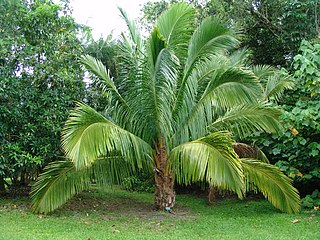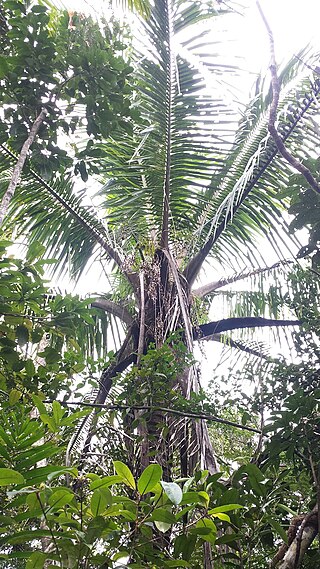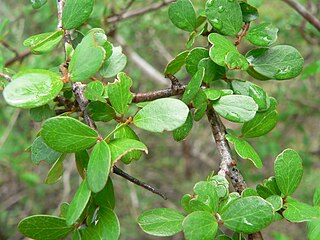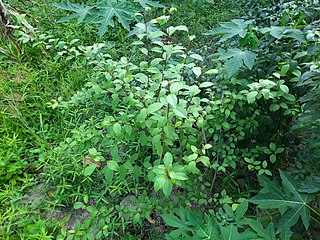
Ravenala is a genus of monocotyledonous flowering plants. Classically, the genus was considered to include a single species, Ravenala madagascariensis, commonly known as the traveller's tree, traveller's palm or East-West palm, from Madagascar. It is not a true palm but a member of the family Strelitziaceae. The genus is closely related to the southern African genus Strelitzia and the South American genus Phenakospermum. Some older classifications include these genera in the banana family (Musaceae). Although it is usually considered to be a single species, four different forms have been distinguished. Five other species were described in 2021, all from Madagascar: Ravenala agatheae Have. & Razanats., R. blancii Have., V.Jeannoda & A.Hladik, R. grandis Have., Razanats, A.Hladik & P.Blanc, R. hladikorum Have., Razanats., V. Jeannoda & P.Blanc, R. madagascariensis Sonn., et R. menahirana Have. & Razanats.
Decaryochloa is a genus of Madagascan bamboo in the grass family.
Kaliphora madagascarensis is a species of evergreen shrub or small tree. It is endemic to Madagascar, where it inhabits subhumid woodlands and forests in eastern Madagascar, in the provinces of Antananarivo, Antsiranana, Fianarantsoa, and Mahajanga.
Borassus madagascariensis is a species in the palm family Arecales endemic to Madagascar.
Podocarpus madagascariensis is a species of conifer in the family Podocarpaceae. It is found only in Madagascar.

Beccariophoenix is a genus of three species of Arecaceae (palms), native to Madagascar. The genus is closely related to the Cocos, or coconut genus, and notably Beccariophoenix alfredii is similar in appearance to the coconut palm. It was named after Odoardo Beccari (1843-1920).
Dypsis ligulata is a species of flowering plant in the family Arecaceae. It is found only in Madagascar. It is threatened by habitat loss.

Lemurophoenix halleuxii is a species of palm tree, the only species in the genus Lemurophoenix. It is found only in Madagascar. It is threatened by habitat loss and overcollection. There are perhaps 300 mature individuals remaining in the wild.

Voanioala gerardii, commonly known as the forest coconut, is a species of flowering plant in the family Arecaceae. It is a relative of the coconut, and is generally regarded as monotypic within the genus Voanioala. However, a team of geneticists headed by Bee F. Gunn found sufficient genetic variation within Voanioala to constitute at least two and possibly four cryptospecies. Voanioala is endemic to Madagascar, and is threatened by habitat loss. Voanioala is harvested for its edible seeds and palm heart. It is estimated that there are fewer than 15 mature trees remaining.

Khaya madagascariensis is a species of plant in the family Meliaceae. It is found in Comoros and Madagascar.
Mangerivola Special Reserve is a wildlife reserve in the east of Madagascar. It was established in 1958 and is a hotspot for bird-watchers due to the one hundred species found there, including 63 endemics and many local endemics. There are also seven species of lemur and rare chameleons such as the Lance-nosed chameleon which is registered as endangered on the IUCN Red List of Threatened Species.

Beccariophoenix alfredii, also known as the high plateau coconut palm, is a recently discovered species of Arecaceae (palms), endemic to Madagascar. It is in the genus Beccariophoenix, and is closely related to the genus Cocos. Beccariophoenix alfredii is very similar in appearance to the coconut palm, although somewhat cold hardy, making it a good look-alike for the coconut in cooler climates.
Cathariostachys madagascariensis, the Madagascar giant bamboo or volohosy in Malagasy language, is a bamboo species found in Madagascar.

The flora of Madagascar consists of more than 12,000 species of plants, as well as a poorly known number of fungi and algae. Around 83% of Madagascar's vascular plants are found only on the island. These endemics include five plant families, 85% of the over 900 orchid species, around 200 species of palms, and such emblematic species as the traveller's tree, six species of baobab and the Madagascar periwinkle. The high degree of endemism is due to Madagascar's long isolation following its separation from the African and Indian landmasses in the Mesozoic, 150–160 and 84–91 million years ago, respectively. However, few plant lineages remain from the ancient Gondwanan flora; most extant plant groups immigrated via across-ocean dispersal well after continental break-up.
Cinnamosma madagascariensis is a species of flowering plant in the family Canellaceae. It is endemic to Madagascar., where it is known as sakaihazo.

Tsitongambarika is a lowland forest in the north of Fort-Dauphin, village Iabakoho, Anosy in southern Madagascar. The area supports many rare species of amphibians, birds, lemurs and reptiles; many of which are endemic. In 2001, the site was designated as an Important Bird Area by BirdLife International and in 2015, an area of 600 km² received environmental protection by the government. The reserve is the recipient of monies raised by the 2016 Rutland Birdfairin.
Beccariophoenix fenestralis is a species of plant in the family Arecaceae. It was described as a species distinct from Beccariophoenix madagascariensis in 2014.
Pilgerina is a monotypic genus of flowering plants belonging to the family Santalaceae. It only contains one known species, Pilgerina madagascariensis.

Commiphora madagascariensis, with the common name Madagascar corkwood, is a flowering plant in the family Burseraceae. The species is native to Tanzania, introduced into India.
Ephippiandra madagascariensis is a species of flowering plant endemic to Madagascar, where it is known as ambora.










